Henry Gee's Blog, page 11
June 12, 2022
Don’t Try This At Home
As you’ll both be aware I am in the middle of changing from one Brain Care Medication to another. Last week I was just starting a week of zero venlafaxine (trades under Vensir, Vencarm, Venlalix, Voldemort, Vadermort, Vulcan Bomber — have you seen one of those things? I was under a low-flying one in Cambridge once and the entire sky went dark — Vengeance Weapon of DOOOOM, Efexor, Effuxxxor of Luxor, Venlablue, Wave Upon Wave of Demented Avengers, The Embalmer, the Death Star, &c. &c.) after a steady, three-week process of reducing the dose.
Well, today is the last day of nothing. As from tomorrow I shall be starting tiny weeny doses of a new drug, vortioxetine. The stripe I’ll be on is called Brintel lix which sounds like the name of one of Asterix the Gaul‘s cousins, perhaps the Ygor-like assistant of Getafix the Druid who actually has to go out and score the Herb and the Shrooms off unmentionable shadowy woodland creatures in the wide lands of Armorica. The introductory dose – 5mg daily – does hardly anything more than step across the threshold of my weary wrung-out interior landscape and suggests politely that it might put out the trash and do the washing up. Only when it’s really got its busy scampering little feet under the table will it start having a good clear out, hoovering behind the wallpaper and inside the lightbulbs and generally bossing me about to look sharpish and Bristol fashion and not go around wearing that rag on my head (see picture top right) if only because a small girl came up to me just yesterday while I was out shopping for atonal apples and amplified heat that she thought I looked like a pirate when what Mrs Gee says is I look like an ageing biker who’s forgotten where he’s parked his Harley but what do I care now I am over 60 I have decided not to care a flying ferruginous ferrule, nay, not even for a fragmented fissile femtosecond, what anyone thinks of me any more notwithstanding inasmuch as which I shall be up to 20mg daily with the earnest sincere hope that I can pretty much stay that way forever. Yes, I have undergone this process before, several times, but it’s never been this bad, and I really really reeely don’t want to go through this again.
lix which sounds like the name of one of Asterix the Gaul‘s cousins, perhaps the Ygor-like assistant of Getafix the Druid who actually has to go out and score the Herb and the Shrooms off unmentionable shadowy woodland creatures in the wide lands of Armorica. The introductory dose – 5mg daily – does hardly anything more than step across the threshold of my weary wrung-out interior landscape and suggests politely that it might put out the trash and do the washing up. Only when it’s really got its busy scampering little feet under the table will it start having a good clear out, hoovering behind the wallpaper and inside the lightbulbs and generally bossing me about to look sharpish and Bristol fashion and not go around wearing that rag on my head (see picture top right) if only because a small girl came up to me just yesterday while I was out shopping for atonal apples and amplified heat that she thought I looked like a pirate when what Mrs Gee says is I look like an ageing biker who’s forgotten where he’s parked his Harley but what do I care now I am over 60 I have decided not to care a flying ferruginous ferrule, nay, not even for a fragmented fissile femtosecond, what anyone thinks of me any more notwithstanding inasmuch as which I shall be up to 20mg daily with the earnest sincere hope that I can pretty much stay that way forever. Yes, I have undergone this process before, several times, but it’s never been this bad, and I really really reeely don’t want to go through this again.
If a week is a long time in Popocatépetl – stratovolcanoes have gravity fields that could, oh, I don’t know, dilate time — it has been hogspittingly fartjangling expletive eternity round here, I can tell you, and no, that’s not a joke about Norfolk. For example I wrote the earlier communique just a week ago but since then I have been through a most extraordinary and not entirely pleasant series of psychic evolutions the like of which I wouldn’t want to wish on anyone except perhaps — no, I don’t want to get sued — but taken together simultaneously and at the same time seem to have been at least as long as the Benzedrene Epoch.
The best parts are when I am asleep. For certain values of the word ‘best’. Venlafaxine has always given me powerful dreams. I have been on it for so long I can’t really remember what Pre-V dreams were like, but my V-dreams, many of which seem to be about commuting (a primitive, extortionately expensive and unnecessary series of contortions that involves breathing the exhaled effluvia of others) were always directed by Tim Burton. That is, they were bright, colourful, in-yer-face and occasionally violent, though sadly Helena Bonham-Carter didn’t appear in any of them. The Dover-Beach-Style Long Wave Goodbye to Effuxxxor of Luxor (though probably Not Nearly Long Enough) has ushered in a new flavour to my dreams. They are now directed by Wes Anderson, which means that the surrealism has become more extensive and subtle as the colour palette has become more muted. I am waiting for a dream in which Owen Wilson and Adrien Brody do a double-act about their failure to find the right London tube line that goes to Cromer.
But getting to sleep has been hard, and when I am awake I quite often feel absolutely dreadful — nobody warned me that withdrawal from the Big V would make me feel quite so very actually ill, I mean, properly ill, as in having to drop what I am doing and go to bed, and sometimes when doing something innocuous like ironing the axolotl or milking the paramecia (helpful hint – you need much smaller tweezers than you’d think) I’d just be doubled up in floods of tears you’d think Noah was right on time and we’d all get washed away with the dodo and a flagon of miniature hedgehogs. So I am often asleep after lunch, or in the early evening — but around one or two a.m. I am wide awake and as busy as a hamster on amphetamines.
I hope things will start to settle down, and that the next Director of Dreams will be Taika Waititi. I could do with some light and undemanding humour. The Hunt for the Wilder People is my favourite movie. Well, actually, Monty Python and the Holy Grail is really my favourite movie, but I don’t think my brain could stand Terry Gilliam. Not that I don’t like and admire films by Terry Gilliam. I can and do. Just not directing what goes on inside my head. Oh, and Guillermo Del Toro.
One thing has happened that has made me very cross. When I post updates on my internal state on social media, most people are very sympathetic, and, thank you, I appreciate these virtual hugs, they really do help. But then there are the people with no medical qualifications or knowledge whatsoever asking damn fool questions about whether I really need to be administering these ‘poisons’ to myself. And other people, full of helpful ‘advice’ about various psychoactive drugs and shouldn’t I be looking into these? I am pleased to say that friends who are qualified have weighed in mightily about the sheer irresponsibility of such vaporings.
Therefore I should say, for the record, that I am not doing any of this for, like, fun. I wouldn’t have come off Wave Upon Wave of Demented Avengers at all if I hadn’t started to become habituated to it, and increasing the dose had no beneficial effects.
More importantly I am at all times under the care of the professionals. My drug advice comes from my Private Brain Care Specialist, and the drugs are administered by my General Practitioner, who did advise me that even the eight-week program she suggested might be extended if I found things to be a bit rocky. If I might get a bit Anglo-Saxon, Hwaet! Éalá Éarendel Engla Beorhtast! People who aren’t qualified, still less know my extensive experience as a Veteran in the Psychic Wars, can Jolly Well Fuck Off. To be serious, those who make pretzels with the insides of their brains as a kind of home-made recreational do-it-yourself science experiment, or take their medical advice from Hieronymous down the pub, are at best fools — at worst, downright dangerous.
Q: How many Veterans of the Psychic Wars does it take to change a light bulb?
A: If you don’t know, man, you weren’t there.
If there is one piece of advice I explore deplore implore you to take home with you, especially if you are already at home, it is this
DON’T TRY THIS AT HOME.
Because doing it inside your own head is much, much worse.
June 6, 2022
Brain Strain
I am a career depressive.
I’ve been on all the drugs.
Back in the day I was on mianserin which they probably only use nowadays to tranquilize rhinos, and even then, only from a long way off.
After I came off that I was clean for years — snorting a bit of St John’s wort, purely recreationally you understand — although that does tend to turn one into a vampire.
But then I slowly slid off the wagon into the arms of citalopram. I splarfed this for many years until it wore out, as these things tend to do. After that came a rocky patch in which I discovered that diazepam turned me into a zombie; mirtazapine a monster; and sertraline did nothing for me whatsoever. It was then that my Private Brain-Care Specialist prescribed venlafaxine, which for at least a decade has kept me from curling up into a fetal position and crying.
But now that, too, has begun to wear off. My Private Brain-Care Specialist (a new one, the previous one having retired) has prescribed vortioxetine. The same Private Brain Care Specialist also sent me some questionnaires which show without fear of contradiction that I am definitely up to my spleen on the Autism Spectrum notwithstanding inasmuch as which definite signs of ADHD, a revelation to which Offspring No. 1’s weltschmerzy response was ‘This Surprises Nobody’. It could explain why I feel as unable to relax as a frog on a griddle; have to be completely unplugged from life in order to avoid going completely Harpic; and my idea of a perfect hell/holiday is probably two weeks in a sensory deprivation chamber. Though Leicestershire is nice.
But I digress. Back to the drugs. I have yet to take any vortioxetine (do at least try to keep up at the back), because — and if you’ve been there, you’ll know this — you can’t simply stop taking one kind of happy juice one day and pop a different one the next. One has to slowly wean oneself off the old stuff, and, only when it’s out of one’s system, gradually up the dose of the new.
This process might take several weeks. As of now I have started a week in which I am taking … wait for it ….
… precisely nothing.
No safety net.
Between the tightrope and the shark-infested lagoon nothing but empty air. Next week I start to take doses of vortioxetine so tiny they wouldn’t trouble a goldfish, and then up the dose in weekly increments until I shall be capable of holding a conversation without zoning out.
 Happily, this slow process hasn’t reduced me to curling up into a fetal position and crying. It has, however, had its effects. Most of the time I feel slightly stoned, rather like Dylan from a Televisual Emission of YesterYore called the Magic Roundabout. Those of a Certain Age will remember Dylan as a hippy rabbit (reputedly named after Bob Dylan) who wandered around in a perpetual funk saying things such as ‘Like. Wow. Man’.
Happily, this slow process hasn’t reduced me to curling up into a fetal position and crying. It has, however, had its effects. Most of the time I feel slightly stoned, rather like Dylan from a Televisual Emission of YesterYore called the Magic Roundabout. Those of a Certain Age will remember Dylan as a hippy rabbit (reputedly named after Bob Dylan) who wandered around in a perpetual funk saying things such as ‘Like. Wow. Man’.
When not feeling stoned I do have the sense of Matches Not Striking On Box. Occasionally I start to cry for no reason. And I am always tired. But that could just be my age.
There is a plus side, though. I am taking advantage of my somewhat trippy state to read a book I’d probably have no patience with otherwise. And it’s doing wonders for my musical creativity. I’m now deep into the Difficult Second Album of my current musical project, G&T (more about that here). I can now understand why musicians and drugs go together like, well, musicians and rugs. I meant drugs. Not rugs. Especially as they get older because, you know, when you are over 60, which I am, you get free drugs. The rugs though are extra. Butterflies. Possibly. And wheels.
May 29, 2022
What I Read In May
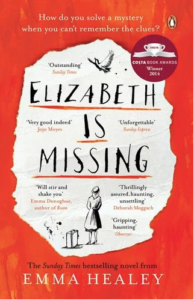 Emma Healey: Elizabeth Is Missing I actually read this (and Little Egypt, below) in April, but squeezed it in at the very end during a weekend in which I had to see a man about a dog (no, really) so they’ve been extruded into May. I don’t know why I am telling you this. After all, why would you care? But I Digress. There are many stories with a first-person protagonist in which it is quite clear that the narrator isn’t really aware of what is really going on. (My favourite is The Remains of the Day by Kazuo Ishiguro). Elizabeth Is Missing takes this a step further. Not only does the protagonist not really know what is going on, but her confusion gets worse, as she is suffering from dementia which starts off moderate and gets worse and worse towards the book’s end. Maud (that’s the protagonist) is a widow in a small seaside town where she has lived all her life. She is obsessed by the apparent disappearance of her friend Elizabeth – but her distress really covers a deeper, older mystery, that of the disappearance of her elder sister Sukey when Maud was a girl, just after the end of the Second World War. Unlike the vague, dreamlike present day, Maud recalls the events of the late nineteen-forties with crystal clarity, even though she’s not always aware what’s going on then, either, as she’s a child from whom the grown-ups are variously trying to hide their own grown-up matters.
Emma Healey: Elizabeth Is Missing I actually read this (and Little Egypt, below) in April, but squeezed it in at the very end during a weekend in which I had to see a man about a dog (no, really) so they’ve been extruded into May. I don’t know why I am telling you this. After all, why would you care? But I Digress. There are many stories with a first-person protagonist in which it is quite clear that the narrator isn’t really aware of what is really going on. (My favourite is The Remains of the Day by Kazuo Ishiguro). Elizabeth Is Missing takes this a step further. Not only does the protagonist not really know what is going on, but her confusion gets worse, as she is suffering from dementia which starts off moderate and gets worse and worse towards the book’s end. Maud (that’s the protagonist) is a widow in a small seaside town where she has lived all her life. She is obsessed by the apparent disappearance of her friend Elizabeth – but her distress really covers a deeper, older mystery, that of the disappearance of her elder sister Sukey when Maud was a girl, just after the end of the Second World War. Unlike the vague, dreamlike present day, Maud recalls the events of the late nineteen-forties with crystal clarity, even though she’s not always aware what’s going on then, either, as she’s a child from whom the grown-ups are variously trying to hide their own grown-up matters.
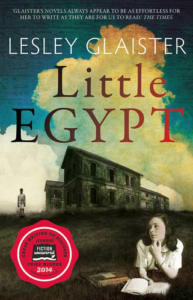 Lesley Glaister: Little Egypt Many years ago when the world was young I enjoyed bidding in a charity silent auction in aid of our local high school. Among the lots were a keg of beer (which attracted many bids); and a bundle of books from Salt Publishing, Cromer’s very own literary publishing house (which attracted just one bid – mine). I read one of the books, The Lighthouse by Alison Moore, but it was so depressing that the thought of any mo(o)re in that vein put me off for years. Little Egypt, though, was a tonic. I was attracted because it is based around one of my favourite settings — a large country pile in an advanced state of decay, with secrets piled on secrets. Indeed, the house is the title character. Little Egypt is a grand house in the north of England. Like many grand houses, the First World War pretty much did for it, and the spendthrift owners progressively sold off more of the land until it is a small island completely cut off from the rest of the world by a railway line, a dual carriageway and a superstore. Although dilapidated, it is still inhabited by nonagenarian twins Isis and Osiris, whose childhoods had been scarred by their abandonment in the house, during the 1920s, by their Egyptologist parents who were forever in Egypt squandering their wealth on a search for the fabled Tomb of Herihor. As the story opens, Osiris has long ago descended from eccentricity into madness, but Isis is still as sharp as a tack. For years she has been courted by a developer who wants to buy Little Egypt so it can be levelled to make way for yet another superstore. Isis is sorely tempted … until she remembers the awful secrets that the house conceals. In many ways the book is like Elizabeth is Missing in that it alternates between the girlhood and old age of the central character. The only flaw for me was a section in the middle in which the young twins actually travel to Egypt to see their awful parents. This seemed to go on longer than necessary. Mainly, I think, because those scenes didn’t feature the slowly decaying mansion, against which the tombs and temples of ancient Egypt seemed fresh and new.
Lesley Glaister: Little Egypt Many years ago when the world was young I enjoyed bidding in a charity silent auction in aid of our local high school. Among the lots were a keg of beer (which attracted many bids); and a bundle of books from Salt Publishing, Cromer’s very own literary publishing house (which attracted just one bid – mine). I read one of the books, The Lighthouse by Alison Moore, but it was so depressing that the thought of any mo(o)re in that vein put me off for years. Little Egypt, though, was a tonic. I was attracted because it is based around one of my favourite settings — a large country pile in an advanced state of decay, with secrets piled on secrets. Indeed, the house is the title character. Little Egypt is a grand house in the north of England. Like many grand houses, the First World War pretty much did for it, and the spendthrift owners progressively sold off more of the land until it is a small island completely cut off from the rest of the world by a railway line, a dual carriageway and a superstore. Although dilapidated, it is still inhabited by nonagenarian twins Isis and Osiris, whose childhoods had been scarred by their abandonment in the house, during the 1920s, by their Egyptologist parents who were forever in Egypt squandering their wealth on a search for the fabled Tomb of Herihor. As the story opens, Osiris has long ago descended from eccentricity into madness, but Isis is still as sharp as a tack. For years she has been courted by a developer who wants to buy Little Egypt so it can be levelled to make way for yet another superstore. Isis is sorely tempted … until she remembers the awful secrets that the house conceals. In many ways the book is like Elizabeth is Missing in that it alternates between the girlhood and old age of the central character. The only flaw for me was a section in the middle in which the young twins actually travel to Egypt to see their awful parents. This seemed to go on longer than necessary. Mainly, I think, because those scenes didn’t feature the slowly decaying mansion, against which the tombs and temples of ancient Egypt seemed fresh and new.
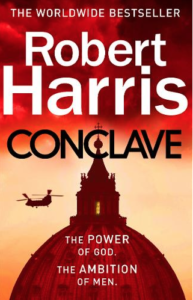 Robert Harris: Conclave Were you to pick up and read the kind of thriller customarily sold at airports, and then say to yourself ‘that’s easy, any fool can write a book like that’ — think again. It isn’t. The careful charting of plot; the creation of characters that are believable enough for you to care about them (but no more); the display of vast amounts of research in such a way as it enhances the story rather than detracts from it; all require consummate craft and skill as a writer. Few have more craft or skill than Robert Harris. Probably best known for Fatherland (an alternative history set in the 1960s after Hitler won the war), I first discovered Harris with Pompeii, an adventure set just before the eruption of Vesuvius in 79CE. Although Harris tends to write a lot about the Romans and the Second World War, he has branched out into black humour (Ghost, in which a writer is tasked with ghosting the memoirs of a Prime Minister who looks a lot like Tony Blair); SF (The Fear Index, in which a computer on the stock market goes rogue) , and much else (my favourite is An Officer and a Spy, about the Dreyfus Affair). Clearly, Harris likes to set himself a challenge. To make a thriller out of the election of a new Pope would seem a tall order, given that almost all the characters are elderly men in frocks. Despite an almost total lack of sex or violence, and no car chases (but oh! the costumes!) Harris weaves a truly unputdownable tale about the election of a (fictional) Pope. The incumbent Pope has died after a long illness during which he has left several loose ends and made several seemingly unusual decisions. It falls to Cardinal Jacopo Lomeli, the Dean of the College of Cardinals, to organise the conclave of 118 of his fractious fellows in which a successor will be elected. Cue a great deal of intrigue, politicking, quotations from the Bible and some jaw-dropping plot twists. It might seem odd to write a novel about the Catholic Church these days that is in any way sympathetic. This one is — sympathetic, that is — because despite nods to the ongoing scandals involving sex abuse by the clergy, and the financial chicanery with which the Pontifical bank accounts have been associated, the protagonist is a fundamentally good man. Lomeli has spent a life in the Church, and despite his own repeated bouts of Imposter Syndrome he is clearly devout, well-liked, tactful and skilled in untangling the various problems that the task of running the conclave throws up. And if after reading this book you don’t know everything there is to know about running a Papal conclave, you’ve been reading a completely different book.
Robert Harris: Conclave Were you to pick up and read the kind of thriller customarily sold at airports, and then say to yourself ‘that’s easy, any fool can write a book like that’ — think again. It isn’t. The careful charting of plot; the creation of characters that are believable enough for you to care about them (but no more); the display of vast amounts of research in such a way as it enhances the story rather than detracts from it; all require consummate craft and skill as a writer. Few have more craft or skill than Robert Harris. Probably best known for Fatherland (an alternative history set in the 1960s after Hitler won the war), I first discovered Harris with Pompeii, an adventure set just before the eruption of Vesuvius in 79CE. Although Harris tends to write a lot about the Romans and the Second World War, he has branched out into black humour (Ghost, in which a writer is tasked with ghosting the memoirs of a Prime Minister who looks a lot like Tony Blair); SF (The Fear Index, in which a computer on the stock market goes rogue) , and much else (my favourite is An Officer and a Spy, about the Dreyfus Affair). Clearly, Harris likes to set himself a challenge. To make a thriller out of the election of a new Pope would seem a tall order, given that almost all the characters are elderly men in frocks. Despite an almost total lack of sex or violence, and no car chases (but oh! the costumes!) Harris weaves a truly unputdownable tale about the election of a (fictional) Pope. The incumbent Pope has died after a long illness during which he has left several loose ends and made several seemingly unusual decisions. It falls to Cardinal Jacopo Lomeli, the Dean of the College of Cardinals, to organise the conclave of 118 of his fractious fellows in which a successor will be elected. Cue a great deal of intrigue, politicking, quotations from the Bible and some jaw-dropping plot twists. It might seem odd to write a novel about the Catholic Church these days that is in any way sympathetic. This one is — sympathetic, that is — because despite nods to the ongoing scandals involving sex abuse by the clergy, and the financial chicanery with which the Pontifical bank accounts have been associated, the protagonist is a fundamentally good man. Lomeli has spent a life in the Church, and despite his own repeated bouts of Imposter Syndrome he is clearly devout, well-liked, tactful and skilled in untangling the various problems that the task of running the conclave throws up. And if after reading this book you don’t know everything there is to know about running a Papal conclave, you’ve been reading a completely different book.
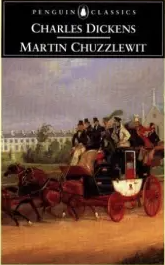 Charles Dickens: Martin Chuzzlewit Some wag said of Wagner’s music that it has wonderful moments and dreadful quarters-of-an-hour. One can say much the same of this lesser-known Dickens novel (serialised between 1843 and 1844). Although Dickens felt at the time that it was ‘immeasurably the best of my stories’, reception fell rather flat. Not that it is without its charms. To be sure, it’s no Pickwick Papers or Oliver Twist, but it would be an insensitive reader who didn’t find much to enjoy in this this humungous chungus of a doorstop (my edition runs to more than 900 pages), rather in the way that there are bound to be quite a few plums in a plum pudding, if it is big enough. The baggy plot is subservient to the moralising character. It is a study in hypocrisy and selfishness from the personal and parochial of Mr Pecksniff to the corporate and criminal of the Anglo-Bengalee Disinterested Life Assurance and Loan Company. Confusingly, there are not one but two Martin Chuzzlewits – the elder, eccentric and miserly; and the younger, his conceited and snobbish grandson. But wait, there’s more. Chuzzlewits abound, including (but not limited to) Anthony (the Elder Martin’s brother); Mr Pecksniff himself (a distant Chuzzlewit cousin); and his daughters Charity and Mercy (flinty and flighty respectively) but especially the horrible Jonas. In fact, the book is fair stuffed with Chuzzlewits, and there are times when there is so much Chuzzlewittery one can hardly move: the book really should have been called ‘The Chuzzlewit Saga’. To this concatenation of Chuzzlewits may be added a cavalcade of characters, from the virtuous Tom Pinch to the jolly Mark Tapley (who stands to young Martin as Sam Weller does to Mr Pickwick), although it’s Dickens’ female characters that really stand out. Apart from the Chuzzlewit daughters, there’s the put-upon boarding-house proprietor Mrs Todgers; the American literary celebrity Mrs Hominy; the warm-hearted publican Mrs Lupin — and especially the dipsomaniac nurse Mrs Gamp, who drops in every so often to give us a soliloquy on her imaginary friend Mrs Harris, just when the story is about to flag. In fact, I’d say Mrs Gamp transcends the novel to stand as one of Dickens’ finest comic creations. Sadly, the other female principals — Tom Pinch’s sister Ruth and the elder Martin’s confidante Ruth Graham — have traded character for near-saccharine virtue. Halfway through the novel, the young Martin and Mark Tapley sail to America to seek their fortunes, an episode that ends in disaster. Dickens had not long returned from his first visit to America. He went full of hope for the young Republic, but came home thoroughly disenchanted. The American episode in Martin Chuzzlewit is an excoriating satire on the towering self-regard of a people devoted to money at all or any cost, and who have nothing whatsoever to recommend them. Indeed, every dreadful habit, from spitting chewed tobacco to the owning of slaves to the bearing of weapons, is regarded as an Institution; the people who spit and shoot and own slaves among the ‘finest Men in the Country’. Such intellectual pursuits as there are take the form of political theorising that goes so far beyond the capacity of their own authors as to be completely unintelligible. The new nation is so deep-dyed in hypocrisy that people there seem to take an unusual interest in the aristocracy of a country – Britain – they affect to despise. It is in the American episode that Dickens’ sarcasm bites hardest. Here, a character encountered on a steamboat:
Charles Dickens: Martin Chuzzlewit Some wag said of Wagner’s music that it has wonderful moments and dreadful quarters-of-an-hour. One can say much the same of this lesser-known Dickens novel (serialised between 1843 and 1844). Although Dickens felt at the time that it was ‘immeasurably the best of my stories’, reception fell rather flat. Not that it is without its charms. To be sure, it’s no Pickwick Papers or Oliver Twist, but it would be an insensitive reader who didn’t find much to enjoy in this this humungous chungus of a doorstop (my edition runs to more than 900 pages), rather in the way that there are bound to be quite a few plums in a plum pudding, if it is big enough. The baggy plot is subservient to the moralising character. It is a study in hypocrisy and selfishness from the personal and parochial of Mr Pecksniff to the corporate and criminal of the Anglo-Bengalee Disinterested Life Assurance and Loan Company. Confusingly, there are not one but two Martin Chuzzlewits – the elder, eccentric and miserly; and the younger, his conceited and snobbish grandson. But wait, there’s more. Chuzzlewits abound, including (but not limited to) Anthony (the Elder Martin’s brother); Mr Pecksniff himself (a distant Chuzzlewit cousin); and his daughters Charity and Mercy (flinty and flighty respectively) but especially the horrible Jonas. In fact, the book is fair stuffed with Chuzzlewits, and there are times when there is so much Chuzzlewittery one can hardly move: the book really should have been called ‘The Chuzzlewit Saga’. To this concatenation of Chuzzlewits may be added a cavalcade of characters, from the virtuous Tom Pinch to the jolly Mark Tapley (who stands to young Martin as Sam Weller does to Mr Pickwick), although it’s Dickens’ female characters that really stand out. Apart from the Chuzzlewit daughters, there’s the put-upon boarding-house proprietor Mrs Todgers; the American literary celebrity Mrs Hominy; the warm-hearted publican Mrs Lupin — and especially the dipsomaniac nurse Mrs Gamp, who drops in every so often to give us a soliloquy on her imaginary friend Mrs Harris, just when the story is about to flag. In fact, I’d say Mrs Gamp transcends the novel to stand as one of Dickens’ finest comic creations. Sadly, the other female principals — Tom Pinch’s sister Ruth and the elder Martin’s confidante Ruth Graham — have traded character for near-saccharine virtue. Halfway through the novel, the young Martin and Mark Tapley sail to America to seek their fortunes, an episode that ends in disaster. Dickens had not long returned from his first visit to America. He went full of hope for the young Republic, but came home thoroughly disenchanted. The American episode in Martin Chuzzlewit is an excoriating satire on the towering self-regard of a people devoted to money at all or any cost, and who have nothing whatsoever to recommend them. Indeed, every dreadful habit, from spitting chewed tobacco to the owning of slaves to the bearing of weapons, is regarded as an Institution; the people who spit and shoot and own slaves among the ‘finest Men in the Country’. Such intellectual pursuits as there are take the form of political theorising that goes so far beyond the capacity of their own authors as to be completely unintelligible. The new nation is so deep-dyed in hypocrisy that people there seem to take an unusual interest in the aristocracy of a country – Britain – they affect to despise. It is in the American episode that Dickens’ sarcasm bites hardest. Here, a character encountered on a steamboat:
His complexion, naturally muddy, was rendered muddier still by too strict an economy of soap and water; and the same observation will apply to the washable part of his attire, which he might have changed with comfort to himself and gratification to his friends … He was not singular, to be sure, in these respects, for every gentleman on board appeared to have had a difference with his laundress, and to have left off washing himself in early youth.
The character is not some vagrant or backwoodsman, but a member of Congress, and (of course) ‘one of the finest men in the country’.
Dickens’ observations of America were so cutting that he was obliged to insert a postscript apologising for it. However, many of his observations seem (the part about personal hygiene excepted) to be as apposite today as they were when Dickens made them almost 180 years ago.
May 18, 2022
Hocus Pocus
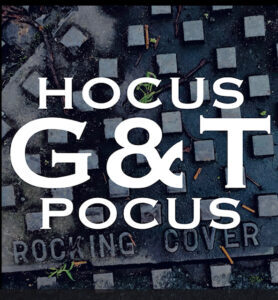 Greetings, Pop Pickers. Music fans of a certain vintage will recall with a wry smile the tune Hocus Pocus by the Dutch prog rock band Focus, in which the inspired lunacy of organist, vocalist and flautist Thijs van Leer met the guitar virtuosity of Jan Akkerman. Always willing to try something new, and having no shame whatsoever, my current musical project G&T has done a cover version. It’ll be released for download on Apple Music, iTunes and so on and so forth on 27 May, but those of a less patient nature can pre-save it on Spotify and Apple Music now. Adrian Thomas played guitar, more guitar, extra guitar, additional guitar, further guitar, with a side-order of guitar and a guitar jus. I did other stuff, and mixed it here at Flabbey Road. If you are impatient to hear more from G&T (and why not?) our album Ice & A Slice is widely available. And we’re currently recording some new material for release sometime in the future. Watch, as they say, this space. Not ‘arf!
Greetings, Pop Pickers. Music fans of a certain vintage will recall with a wry smile the tune Hocus Pocus by the Dutch prog rock band Focus, in which the inspired lunacy of organist, vocalist and flautist Thijs van Leer met the guitar virtuosity of Jan Akkerman. Always willing to try something new, and having no shame whatsoever, my current musical project G&T has done a cover version. It’ll be released for download on Apple Music, iTunes and so on and so forth on 27 May, but those of a less patient nature can pre-save it on Spotify and Apple Music now. Adrian Thomas played guitar, more guitar, extra guitar, additional guitar, further guitar, with a side-order of guitar and a guitar jus. I did other stuff, and mixed it here at Flabbey Road. If you are impatient to hear more from G&T (and why not?) our album Ice & A Slice is widely available. And we’re currently recording some new material for release sometime in the future. Watch, as they say, this space. Not ‘arf!
April 28, 2022
What I Read In April
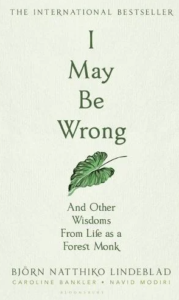
Björn Natthiko Lindeblad: I May Be Wrong ‘Oh, your poor brain’, says Mrs Gee, when she sees the stack of things I really must read; the list of tasks I give myself. Then she passed me this book. Now, you’ll rarely hardly ever never catch me reading anything from the ‘Self Help’ shelves, let alone the ‘Mind, Body & Spirit’ section, and after this I needn’t bother. This small book has given me all I need. The author was a successful young businessman until he realised, as some greyhounds will, that the hare they are chasing will forever be out of reach, and even when they reach it, it’ll actually only be a stuffed toy. So he gave it all up and became a Buddhist monk, living in a jungle in Thailand. After seventeen years he had another epiphany, left the order, and, after a period of depression, reinvented himself as a teacher of meditation and a motivational speaker. While reading this I discovered that I really needn’t pay any attention to those nagging thoughts telling me what I am doing wrong; that I should trust my own instincts more; to enjoy the moment; and to face life with equanimity. We can do nothing about the past, so there is no point in regret or bearing grudges. And, as that famous Buddhist Robert Burns once said, the best laid plans of mice and men gang aft agley, so it’s no point worrying if the plans you’ve made go rogue. The present moment is the only moment that’s real, so we should live in it, and appreciate it as it happens. When asked by a journalist what one thing he’d learned from a life of contemplation, the author said ‘I no longer believe my every thought’. In other words, I May Be Wrong. I think there is something in here for science, which, as you all both know, is what I spend a lot of time thinking about. Science is not about the accumulation of facts, but the quantification of doubt. Any scientific discovery is only ever provisional, so there’s no point hanging on too tightly to your pet theory, or being angry when another scientist shows that your line of inquiry might, in fact, be mistaken. Some scientists might feel better about life if they started off being humbler about the evidence. I think I have already begun to adopt some of Lindeblad’s tips, albeit without knowing it. I have done my best to avoid management. The quest for status is, to me, like chasing a hare that turns out to be fake. Who needs it? Who wants it? And what is actually the point of all those meetings? By avoiding all that clutter I have been able to enjoy my job more than, I suspect, most people enjoy theirs. Lindeblad loves to tell stories, and one comes from that great Buddhist teacher, Winnie-the-Pooh. While walking through the Hundred Aker Wood, Pooh and Piglet agree that their friend Rabbit is awfully clever. He has Brain. Maybe that’s why, says Pooh, he never understands anything. Perhaps, after all, there is another self-help book I should read – The Tao of Pooh.
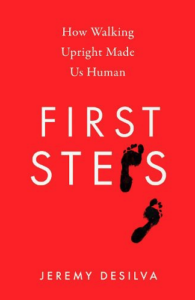 Jeremy DeSilva: First Steps I paused at the top of the stairs and bent down to pet the dog, who usually liked to sleep there. But I misjudged my balance, slipped down several steps, and came to a halt when my left foot slammed into the return wall. The resulting broken ankle left me almost completely helpless. It was only thanks to the ministrations of the vast panjandrum that is the National Health Service that I could get better. That, and the more proximate care of the unflagging Mrs Gee, who enjoyed the experience so much that she decided to retrain as a nurse (specialising in patients with learning disabilities — go figure). Even the dog said she was sorry. While in hospital I reflected that my next book would be called Bugger Bipedalism, and would look at why it is that we humans, almost uniquely among mammals, are habitual bipeds, when the habit is obviously, transparently and ridiculously maladaptive. Jeremy De Silva saved me the trouble, and shows that my bedridden state was not unique. The painful and expensive burden of fractures to bones from hip to toe; slipped discs; torn cruciate ligaments (and the many other ailments of knees); hernias; prolapses; plantar fasciitis; sciatica; death in childbirth, and many other ills are a direct consequence of our having rotated a structure that was meant to be horizontal through ninety degrees. The rewards, though, have been just about worth the effort. A short walk every day won’t help you lose weight, because human walking is an extraordinarily energy-efficient means of getting around. It might, however, reduce your risk of getting breast cancer, Alzheimer’s or heart disease and is known to alleviate low mood. Our top half, relieved from the burden of walking, can do more things — notably, to be able to control breathing sufficiently well that our ancestors could invent spoken language. And the utter helplessness of one who breaks a leg may have prompted the evolution of a compassionate side to human nature. The fossil record of human walking is thin, but just big enough to show that some of our bipedal, pre-human cousins recovered from otherwise debilitating fractures, rather than being left on the savannah to be eaten by a passing leopard. The ministrations of Mrs Gee have a long history and might have been what made us human.
Jeremy DeSilva: First Steps I paused at the top of the stairs and bent down to pet the dog, who usually liked to sleep there. But I misjudged my balance, slipped down several steps, and came to a halt when my left foot slammed into the return wall. The resulting broken ankle left me almost completely helpless. It was only thanks to the ministrations of the vast panjandrum that is the National Health Service that I could get better. That, and the more proximate care of the unflagging Mrs Gee, who enjoyed the experience so much that she decided to retrain as a nurse (specialising in patients with learning disabilities — go figure). Even the dog said she was sorry. While in hospital I reflected that my next book would be called Bugger Bipedalism, and would look at why it is that we humans, almost uniquely among mammals, are habitual bipeds, when the habit is obviously, transparently and ridiculously maladaptive. Jeremy De Silva saved me the trouble, and shows that my bedridden state was not unique. The painful and expensive burden of fractures to bones from hip to toe; slipped discs; torn cruciate ligaments (and the many other ailments of knees); hernias; prolapses; plantar fasciitis; sciatica; death in childbirth, and many other ills are a direct consequence of our having rotated a structure that was meant to be horizontal through ninety degrees. The rewards, though, have been just about worth the effort. A short walk every day won’t help you lose weight, because human walking is an extraordinarily energy-efficient means of getting around. It might, however, reduce your risk of getting breast cancer, Alzheimer’s or heart disease and is known to alleviate low mood. Our top half, relieved from the burden of walking, can do more things — notably, to be able to control breathing sufficiently well that our ancestors could invent spoken language. And the utter helplessness of one who breaks a leg may have prompted the evolution of a compassionate side to human nature. The fossil record of human walking is thin, but just big enough to show that some of our bipedal, pre-human cousins recovered from otherwise debilitating fractures, rather than being left on the savannah to be eaten by a passing leopard. The ministrations of Mrs Gee have a long history and might have been what made us human.
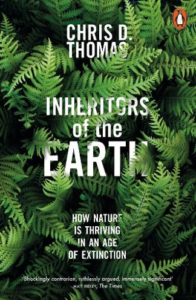 Chris D. Thomas: Inheritors of the Earth The Monterey Pine is endangered. A goldilocks species that’s picky about where it lives, it clings forlornly to a few clifftops in California. As if to add insult to injury, it is deserted by the iconic Monarch butterflies, which seem to prefer the introduced Australian blue gum trees next door. Strenuous efforts are being made to conserve this picturesque pine. But hold – what’s this? – the Monterey pine, like the blue gum, has also been introduced, though in the opposite direction, to the Antipodes. It likes the climate of New Zealand so well that it thrives there, to the extent that it’s become a key part of the local timber industry. This scenario – one of many described in a book that critics whose coin is words such as ‘catastrophe’, ‘extinction’, ’emergency’ and ‘disaster’ can only describe as ‘provocative’ – shows that there are two sides to extinction. For sure, the impact of human beings on the Earth’s climate and ecosystems is serious; the effects, undeniable. But this is not the much-touted ‘Sixth Mass Extinction’ (at least, not yet), and among the less well-publicised effects of human disturbance is the creation – by introduction, geographic separation and hybridisation – of a whole host of new species, at an unprecedented rate. When human beings are gone, they will leave more species in their wake than they inherited. Just not the same ones. This is somewhat embarrassing for conservationists, whose attitude is that the world should be kept in just the way they found it, as if the world they inherited was primeval and changeless but for the arrival of humans (a highly invasive species native to Africa and the result of the hybridisation of at least three different species). Introduced and invasive species are seen as ‘bad’, ‘unnatural’, and fit for extirpation. Such a view is to privilege one moment in time above all others, when the world is in fact always changing, and there is nothing special about any moment above any other. The modish view of conservationists, which, to my mind, is crystallised in the erection of the ‘Anthropocene’, a term that means the geological period in which we all now live, defined by the effects of humans on the environment; a term that reflects a colossal, somewhat patronising and narcissistic hubris, when the remains of human activity in tens of millions of years might be barely detectable, if at all, and leaving aside the practical issue of whether one can create a geological period when one is still living in it. But evolution is ceaselessly active, and human beings are as much a part of nature as the Monterey pine. Species have always come and gone, sometimes slowly, sometimes quickly, and at the same time have crossed continents and hopped between islands. The task for conservationists is, perhaps, to have some humility before the evidence, and, like King Canute was forced to do in the end, go with the flow. Species at risk of extinction should be saved. Of course they should. But perhaps they could be saved not by fruitlessly maintaining them where they happen to be found, but by moving them to places they might find more congenial, particularly in times of rapidly changing climate. The Monterey pine is a case in point. It was saved not by removing invasive species from its last holdouts in California, but by moving it somewhere else. The endangered species becomes — paradoxically — a successful invader.
Chris D. Thomas: Inheritors of the Earth The Monterey Pine is endangered. A goldilocks species that’s picky about where it lives, it clings forlornly to a few clifftops in California. As if to add insult to injury, it is deserted by the iconic Monarch butterflies, which seem to prefer the introduced Australian blue gum trees next door. Strenuous efforts are being made to conserve this picturesque pine. But hold – what’s this? – the Monterey pine, like the blue gum, has also been introduced, though in the opposite direction, to the Antipodes. It likes the climate of New Zealand so well that it thrives there, to the extent that it’s become a key part of the local timber industry. This scenario – one of many described in a book that critics whose coin is words such as ‘catastrophe’, ‘extinction’, ’emergency’ and ‘disaster’ can only describe as ‘provocative’ – shows that there are two sides to extinction. For sure, the impact of human beings on the Earth’s climate and ecosystems is serious; the effects, undeniable. But this is not the much-touted ‘Sixth Mass Extinction’ (at least, not yet), and among the less well-publicised effects of human disturbance is the creation – by introduction, geographic separation and hybridisation – of a whole host of new species, at an unprecedented rate. When human beings are gone, they will leave more species in their wake than they inherited. Just not the same ones. This is somewhat embarrassing for conservationists, whose attitude is that the world should be kept in just the way they found it, as if the world they inherited was primeval and changeless but for the arrival of humans (a highly invasive species native to Africa and the result of the hybridisation of at least three different species). Introduced and invasive species are seen as ‘bad’, ‘unnatural’, and fit for extirpation. Such a view is to privilege one moment in time above all others, when the world is in fact always changing, and there is nothing special about any moment above any other. The modish view of conservationists, which, to my mind, is crystallised in the erection of the ‘Anthropocene’, a term that means the geological period in which we all now live, defined by the effects of humans on the environment; a term that reflects a colossal, somewhat patronising and narcissistic hubris, when the remains of human activity in tens of millions of years might be barely detectable, if at all, and leaving aside the practical issue of whether one can create a geological period when one is still living in it. But evolution is ceaselessly active, and human beings are as much a part of nature as the Monterey pine. Species have always come and gone, sometimes slowly, sometimes quickly, and at the same time have crossed continents and hopped between islands. The task for conservationists is, perhaps, to have some humility before the evidence, and, like King Canute was forced to do in the end, go with the flow. Species at risk of extinction should be saved. Of course they should. But perhaps they could be saved not by fruitlessly maintaining them where they happen to be found, but by moving them to places they might find more congenial, particularly in times of rapidly changing climate. The Monterey pine is a case in point. It was saved not by removing invasive species from its last holdouts in California, but by moving it somewhere else. The endangered species becomes — paradoxically — a successful invader.
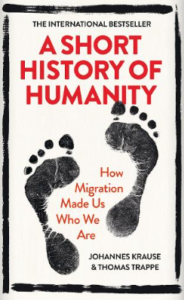 Johannes Krause and Thomas Trappe: A Short History of Humanity. You’ll both be aware that I’ve been reading quite a few horses’-mouth accounts of the latest work in understanding human evolution. See for example my review of Jeremy DeSilva’s First Steps above, and my reviews of Tom Higham’s The World Before Us from March, and Kyle Harper’s Plagues Upon The Earth from February. Here’s another, from Johannes Krause, who, like Svante Pääbo (author of Neanderthal Man) works at the Max Planck Institute for Evolutionary Anthropology in Leipzig. Krause’s story follows a similar course – a laboratory’s discoveries of the nature of human evolution, that modern humans contain fragments of DNA from other species, and so on — but concentrates on the past 10,000 years or so, and mainly deals with Europe. Immigration, it seems, has always been Europe’s story (a theme given a modern context by Krause’s coauthor Trappe, a political journalist who has also followed Krause’s work). There have, in essence, been three major waves of immigration into Europe over the past 10,000 years. The first, of hunter-gatherers, was replaced by a wave of farmers from Anatolia some 8,000 years ago, and this was mingled with a further wave, of equestrian pastoralists around 5,000 years ago. There is more to this, of course, and apart from a few outliers (a corner of Sardinia remains almost pure Anatolia), the people that call themselves European (and that includes Britons) is a mongrel breed, products of these three major waves of immigration, forever intermingled.
Johannes Krause and Thomas Trappe: A Short History of Humanity. You’ll both be aware that I’ve been reading quite a few horses’-mouth accounts of the latest work in understanding human evolution. See for example my review of Jeremy DeSilva’s First Steps above, and my reviews of Tom Higham’s The World Before Us from March, and Kyle Harper’s Plagues Upon The Earth from February. Here’s another, from Johannes Krause, who, like Svante Pääbo (author of Neanderthal Man) works at the Max Planck Institute for Evolutionary Anthropology in Leipzig. Krause’s story follows a similar course – a laboratory’s discoveries of the nature of human evolution, that modern humans contain fragments of DNA from other species, and so on — but concentrates on the past 10,000 years or so, and mainly deals with Europe. Immigration, it seems, has always been Europe’s story (a theme given a modern context by Krause’s coauthor Trappe, a political journalist who has also followed Krause’s work). There have, in essence, been three major waves of immigration into Europe over the past 10,000 years. The first, of hunter-gatherers, was replaced by a wave of farmers from Anatolia some 8,000 years ago, and this was mingled with a further wave, of equestrian pastoralists around 5,000 years ago. There is more to this, of course, and apart from a few outliers (a corner of Sardinia remains almost pure Anatolia), the people that call themselves European (and that includes Britons) is a mongrel breed, products of these three major waves of immigration, forever intermingled.
 Graeme Hall: All Dogs Great and Small My dogs’ favourite TV show is Dogs Behaving (Very) Badly, in which genial, tweed-waistcoat-and-cravat-wearing Yorkshireman Graeme Hall sorts out the problematic behaviour of dogs up and down the land. An abiding theme is that the problems are usually just as much those of the owners as those of the dogs. People fail to realise the acute sensitivity that dogs have to a person’s body language, and although they might not be able to understand the details of human conversations, dogs are very aware of tone of voice. Dogs, you see, have co-evolved with humans for 40,000 years. The two species are, to an extent, symbiotic, and resolving the problematic behaviour of a dog usually requires some re-training of the owner. When watching the show I have wondered (even if my dogs might not have done) how Graeme (we feel we’re on first-name terms with him, chez Gee) got to be where he is today. This book tells all. For more than 20 years Graeme was a senior executive in a food company, until his interest in dogs and dog training took over. The book follows the lives of dogs from milk-sossage to old age, backing up his assertions with the latest scientific evidence, and is as friendly yet as plain-speaking as you’d expect from the Land of the White Rose. And there are lots of rather droll anecdotes. It probably helps if you like dogs — even better if dogs share your home, as one house in three in Britain does — but in any case is a heart-warming read.
Graeme Hall: All Dogs Great and Small My dogs’ favourite TV show is Dogs Behaving (Very) Badly, in which genial, tweed-waistcoat-and-cravat-wearing Yorkshireman Graeme Hall sorts out the problematic behaviour of dogs up and down the land. An abiding theme is that the problems are usually just as much those of the owners as those of the dogs. People fail to realise the acute sensitivity that dogs have to a person’s body language, and although they might not be able to understand the details of human conversations, dogs are very aware of tone of voice. Dogs, you see, have co-evolved with humans for 40,000 years. The two species are, to an extent, symbiotic, and resolving the problematic behaviour of a dog usually requires some re-training of the owner. When watching the show I have wondered (even if my dogs might not have done) how Graeme (we feel we’re on first-name terms with him, chez Gee) got to be where he is today. This book tells all. For more than 20 years Graeme was a senior executive in a food company, until his interest in dogs and dog training took over. The book follows the lives of dogs from milk-sossage to old age, backing up his assertions with the latest scientific evidence, and is as friendly yet as plain-speaking as you’d expect from the Land of the White Rose. And there are lots of rather droll anecdotes. It probably helps if you like dogs — even better if dogs share your home, as one house in three in Britain does — but in any case is a heart-warming read.
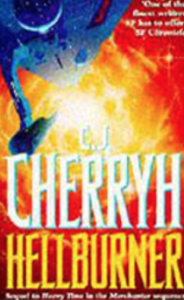 C. J. Cherryh: Hellburner The accomplished and award-winning Hard-SF writer C.J. Cherryh (the second ‘h’ is silent, as in ‘in Hertford, Hereford and Hampshire, Hurricanes ‘Ardly Happen’) writes novels in a believable future history in which humanity has begun to colonise nearby star systems. I read one of these, Downbelow Station, a long time ago, but remember rather little about it. The action of Hellburner is set in the 24th Century when the Earth is at war with the Union, a group of humans long used to colonising outer space. By ‘believable’, action and adventure are repeatedly waylaid by the frustrations of political intrigue, and the very real — and well-portrayed — misunderstandings and prejudices that might result from culture clashes between a complex society based on a planetary surface and a much simpler one based entirely in space. The plot centres on a program by Earth to fly Hellburners — human-piloted spacecraft that fly at sizeable fractions of the speed of light, and the challenges that this will pose for a human crew. Automation is shunned, as this is the strategy likely adopted by the Union, so Earth-based AI stratagems will be second-guessed by the enemy. Such problems are repeatedly discussed in great detail: one is as likely to find oneself in a congressional hearing as a space battle. The title promised me the latter — but I got was the former, and it’s a hard read. As someone once said on viewing Star Wars I: The Phantom Menace, the Trade Federation is a poor substitute for Han Solo. To be fair, Hellburner is a sequel to another novel, Heavy Time, and meant to be read as such — but Wikipedia is great at supplying plot summaries, so I didn’t feel left out. The language has a density which, frankly, takes no prisoners. Here is an example:
C. J. Cherryh: Hellburner The accomplished and award-winning Hard-SF writer C.J. Cherryh (the second ‘h’ is silent, as in ‘in Hertford, Hereford and Hampshire, Hurricanes ‘Ardly Happen’) writes novels in a believable future history in which humanity has begun to colonise nearby star systems. I read one of these, Downbelow Station, a long time ago, but remember rather little about it. The action of Hellburner is set in the 24th Century when the Earth is at war with the Union, a group of humans long used to colonising outer space. By ‘believable’, action and adventure are repeatedly waylaid by the frustrations of political intrigue, and the very real — and well-portrayed — misunderstandings and prejudices that might result from culture clashes between a complex society based on a planetary surface and a much simpler one based entirely in space. The plot centres on a program by Earth to fly Hellburners — human-piloted spacecraft that fly at sizeable fractions of the speed of light, and the challenges that this will pose for a human crew. Automation is shunned, as this is the strategy likely adopted by the Union, so Earth-based AI stratagems will be second-guessed by the enemy. Such problems are repeatedly discussed in great detail: one is as likely to find oneself in a congressional hearing as a space battle. The title promised me the latter — but I got was the former, and it’s a hard read. As someone once said on viewing Star Wars I: The Phantom Menace, the Trade Federation is a poor substitute for Han Solo. To be fair, Hellburner is a sequel to another novel, Heavy Time, and meant to be read as such — but Wikipedia is great at supplying plot summaries, so I didn’t feel left out. The language has a density which, frankly, takes no prisoners. Here is an example:
Carrier was outputting now, making EM noise in a wavefront an enemy would eventually intercept in increasing Doppler effect, and to confuse their longscan they were going to pull a pulse, half up to FTL and abort the bubble, on a heading for the intercept zone — that was the scary part. That was the time, all sims aside, that the theoretical high v became real, .332 light, true hellride, with herself for the com-node that integrated the whole picture.
I can appreciate the artistry that went into this, but it made my head ache. Oh, and for some reason, some of the spacers speak a kind of Franglais. Et pourquoi pas?
 A. E. Moorat: Queen Victoria, Demon Hunter This is one of those burlesques in the subgenre in which historical or well-known but fictional figures are pitted against olives the forces of darkness (qv. Abraham Lincoln, Vampire Hunter; Pride, Prejudice and Zombies, and Albert Einstein, Defender against Nameless Horrors from Other Dimensions). The story is very much the true story of the early part of the reign of Queen Victoria, from her accession, through her marriage to Prince Albert, up to and including the births of her first two children. In other words, very much the same arc as a recent televisual emission in which Jenna Coleman played the young Queen. But that’s not the whole story. Behind the throne is a secret organisation, the Protektorate, sworn to defend Victoria from hideous forces that will rise up from the Pit, usurp the crown, and take over the greatest empire in the world. The story is remarkably good; the action, incredibly gory; and – without spoiling the plot — Victoria is no slouch at decapitating a zombie or two. Perhaps it’s no coincidence that Jenna Coleman was once an all-action companion to Dr Who.
A. E. Moorat: Queen Victoria, Demon Hunter This is one of those burlesques in the subgenre in which historical or well-known but fictional figures are pitted against olives the forces of darkness (qv. Abraham Lincoln, Vampire Hunter; Pride, Prejudice and Zombies, and Albert Einstein, Defender against Nameless Horrors from Other Dimensions). The story is very much the true story of the early part of the reign of Queen Victoria, from her accession, through her marriage to Prince Albert, up to and including the births of her first two children. In other words, very much the same arc as a recent televisual emission in which Jenna Coleman played the young Queen. But that’s not the whole story. Behind the throne is a secret organisation, the Protektorate, sworn to defend Victoria from hideous forces that will rise up from the Pit, usurp the crown, and take over the greatest empire in the world. The story is remarkably good; the action, incredibly gory; and – without spoiling the plot — Victoria is no slouch at decapitating a zombie or two. Perhaps it’s no coincidence that Jenna Coleman was once an all-action companion to Dr Who.
 Larry Niven: Neutron Star The ‘Golden Age’ of science fiction arguably began in the 1930s with John W. Campbell‘s editorship of the pulp magazine Astounding Science Fiction from 1937 until the ‘New Wave’ of SF of the 1960s introduced such affectations as literary sensibility and social conscience. Golden-Age SF stories tended to be ‘hard’ SF (that is, with a strong science component) and concentrated on pace and plot rather than character or literary pretension. If so, Larry Niven’s story Neutron Star (published in Worlds of If in October, 1966) was among the Golden Age’s last gasps. Or, rather, a last hurrah, for the story won awards and is rightly hailed as a classic. In the story, the protagonist Beowulf Shaeffer, ever-impecunious space-pilot-for-hire, is paid by the financially shrewd, technically advanced but pathologically risk-averse Puppeteers to take one of their spaceships on a hyperbolic orbit that will take it within a mile of a neutron star. The story describes the intense tidal forces that such a mission would experience — and all this just a year before neutron stars were actually discovered. The other stories in this collection share the same imagined universe, and several feature Beowulf Shaeffer, the Puppeteers and other aliens including the recklessly warlike Kzint and the strange, plant-like Outsiders. All the stories are painted in the bright primary colours of pulp SF, and yet each is a meticulously crafted example of the storyteller’s art, ending in a satisfying plot twist. After Hellburner, Neutron Star was nothing short of refreshing. Ah, the Good Old Days, when men were real men, women were real women, and small blue creatures from Alpha Centauri were real small blue creatures from Alpha Centauri.
Larry Niven: Neutron Star The ‘Golden Age’ of science fiction arguably began in the 1930s with John W. Campbell‘s editorship of the pulp magazine Astounding Science Fiction from 1937 until the ‘New Wave’ of SF of the 1960s introduced such affectations as literary sensibility and social conscience. Golden-Age SF stories tended to be ‘hard’ SF (that is, with a strong science component) and concentrated on pace and plot rather than character or literary pretension. If so, Larry Niven’s story Neutron Star (published in Worlds of If in October, 1966) was among the Golden Age’s last gasps. Or, rather, a last hurrah, for the story won awards and is rightly hailed as a classic. In the story, the protagonist Beowulf Shaeffer, ever-impecunious space-pilot-for-hire, is paid by the financially shrewd, technically advanced but pathologically risk-averse Puppeteers to take one of their spaceships on a hyperbolic orbit that will take it within a mile of a neutron star. The story describes the intense tidal forces that such a mission would experience — and all this just a year before neutron stars were actually discovered. The other stories in this collection share the same imagined universe, and several feature Beowulf Shaeffer, the Puppeteers and other aliens including the recklessly warlike Kzint and the strange, plant-like Outsiders. All the stories are painted in the bright primary colours of pulp SF, and yet each is a meticulously crafted example of the storyteller’s art, ending in a satisfying plot twist. After Hellburner, Neutron Star was nothing short of refreshing. Ah, the Good Old Days, when men were real men, women were real women, and small blue creatures from Alpha Centauri were real small blue creatures from Alpha Centauri.
 Martin Cruz Smith: Wolves East Dogs Arkady Renko, dogged Moscow detective (introduced in Smith’s 1981 novel Gorky Park), tries in vain to wrest any kind of order from the collapse of the Soviet Union and the rise of the ‘New Russia’, which is every bit as corrupt as the old. Here he investigates the case of millionaire Pasha Ivanov, who has — apparently — thrown himself to his death from his penthouse apartment. This seems out of character for the cheerful, outgoing Ivanov, whose apartment walls are decorated with pictures of himself with notable figures of the day. ‘He embraced Yeltsin and Clinton and the senior Bush. He beamed at Putin, who, as usual, seemed to suck on a sour tooth’. But Ivanov has been acting out of character of late. And the floor of his walk-in closet is covered in — of all things — salt. Renko’s trail leads nowhere. And more than nowhere, for he finds himself chasing leads in the radioactive exclusion zone around the wreck of the Chernobyl nuclear plant, a region inhabited by a bored militia, desperate scientists, shady scavengers and the peasants who refused to leave after one of the reactors blew up in 1986. Renko finds a kind of respite here, perhaps because he has no formal jurisdiction in Ukraine, even enjoying the rustic hospitality of the peasant farmers. ‘Arkady found the pickles crisp and sour, with perhaps a hint of strontium’. The plot is, eventually resolved, although perhaps rather too quickly and neatly after a series of entirely coincidences. But a satisfying read nonetheless. Especially at the moment.
Martin Cruz Smith: Wolves East Dogs Arkady Renko, dogged Moscow detective (introduced in Smith’s 1981 novel Gorky Park), tries in vain to wrest any kind of order from the collapse of the Soviet Union and the rise of the ‘New Russia’, which is every bit as corrupt as the old. Here he investigates the case of millionaire Pasha Ivanov, who has — apparently — thrown himself to his death from his penthouse apartment. This seems out of character for the cheerful, outgoing Ivanov, whose apartment walls are decorated with pictures of himself with notable figures of the day. ‘He embraced Yeltsin and Clinton and the senior Bush. He beamed at Putin, who, as usual, seemed to suck on a sour tooth’. But Ivanov has been acting out of character of late. And the floor of his walk-in closet is covered in — of all things — salt. Renko’s trail leads nowhere. And more than nowhere, for he finds himself chasing leads in the radioactive exclusion zone around the wreck of the Chernobyl nuclear plant, a region inhabited by a bored militia, desperate scientists, shady scavengers and the peasants who refused to leave after one of the reactors blew up in 1986. Renko finds a kind of respite here, perhaps because he has no formal jurisdiction in Ukraine, even enjoying the rustic hospitality of the peasant farmers. ‘Arkady found the pickles crisp and sour, with perhaps a hint of strontium’. The plot is, eventually resolved, although perhaps rather too quickly and neatly after a series of entirely coincidences. But a satisfying read nonetheless. Especially at the moment.
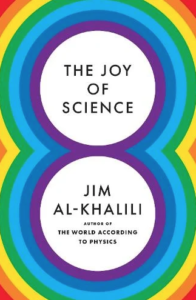 Jim Al-Khalili: The Joy of Science When Winnie-the-Pooh was Stuck in a Tight Place, his friends helped him pass the time by reading him Improving Books. I’d imagine that The Joy of Science might have been on this list. In a volume that is both Small and Tiny, celebrity physicist Jim Al-Khalili, presenter or Radio 4’s The Life Scientific, presents eight bite-sized lessons in how thinking more scientifically will improve your life. It’s certainly helpful to have clear explanations of such things as Cognitive Dissonance, Confirmation Bias, why it is that Otherwise Perfectly Sensible People believe that 5G Masts cause COVID while still being able to put One Foot In Front Of The Other without Falling Over, notwithstanding inasmuch as which What Christopher Robin Does in the Mornings, but there is not, to be fair, very much Joy. Alice, having noted that there are vanishingly few pictures and absolutely no conversation, would have strayed and disappeared down some conspiracy-theoretic rabbit hole. It’s all so very Earnest, you see, and some might say Patronising, though it tries oh so very hard not to be. As Mozart remarked on the Improving qualities of opera in the magic lantern version of Peter Shaffer’s Amadeus, these gods and heroes are so worthy you’d think they shit marble. And who’d really rather not have a chat with their hairdresser than Hercules?
Jim Al-Khalili: The Joy of Science When Winnie-the-Pooh was Stuck in a Tight Place, his friends helped him pass the time by reading him Improving Books. I’d imagine that The Joy of Science might have been on this list. In a volume that is both Small and Tiny, celebrity physicist Jim Al-Khalili, presenter or Radio 4’s The Life Scientific, presents eight bite-sized lessons in how thinking more scientifically will improve your life. It’s certainly helpful to have clear explanations of such things as Cognitive Dissonance, Confirmation Bias, why it is that Otherwise Perfectly Sensible People believe that 5G Masts cause COVID while still being able to put One Foot In Front Of The Other without Falling Over, notwithstanding inasmuch as which What Christopher Robin Does in the Mornings, but there is not, to be fair, very much Joy. Alice, having noted that there are vanishingly few pictures and absolutely no conversation, would have strayed and disappeared down some conspiracy-theoretic rabbit hole. It’s all so very Earnest, you see, and some might say Patronising, though it tries oh so very hard not to be. As Mozart remarked on the Improving qualities of opera in the magic lantern version of Peter Shaffer’s Amadeus, these gods and heroes are so worthy you’d think they shit marble. And who’d really rather not have a chat with their hairdresser than Hercules?
April 23, 2022
In Charnwood Forest
Squeezed into an improbably small space in the very heart of England between Leicester (pronounced ‘Lester’) and Loughborough (pronounced ‘Chicago’) is a magical region called Charnwood Forest. Given the proximity of the amenities of modern life and two fairly large conurbations, Charnwood Forest is the Land that Time Forgot. In the middle of Charnwood Forest is a small village called Woodhouse Eaves. In the middle of Woodhouse Eaves is a small cottage. And, for the past ten days, in the middle of the small cottage was Yours Truly, sent by Mrs Gee who knows the signs when I am just about to lose all connection with reality and go completely Harpic*.
The worries of COVID; the exigencies of working at the Submerged Log Company; and the seemingly relentless round of publicity surrounding my recent tome A (Very) Short History of Sex and Chocolate – all had taken their toll. Now, these are all nice problems to have, but it seems that I have no ‘off’ switch and occasionally need a retreat — by way of a circuit breaker — where I can be quiet and peaceful, on my own, just me, tout seul, and unaccompanied except for my walking boots and a pile of light reading of the kind that Mrs Gee won’t look at and say pityingly ‘Oh, your Poor Brain’.
You could hardly imagine anywhere more quintessentially English than Charnwood Forest. Grand houses and deer parks;
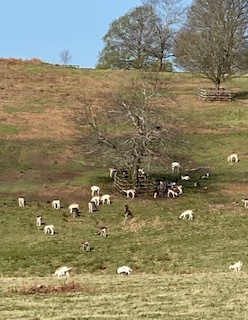
Deer.In a park.
villages with quaint chocolate-box cottages;

these days the gingerbread alone would cost a fortune
water meadows; glittering streams;
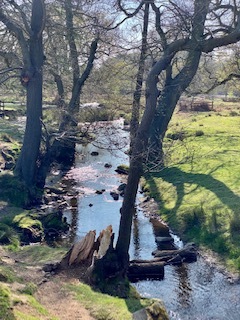
A glittering stream. Recently.
deep forests with the occasional folly straight out of a fairy tale;

Rapunzel, Rapunzel, etc. etc.
romantically craggy outcrops;

A romantic and craggy outcrop
horses, cows, sheep and albino emus.
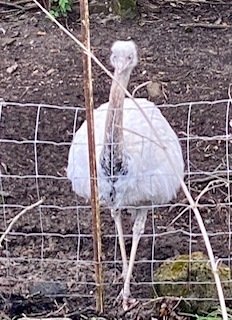
Yes, you read that right. Albino emus. In Leicestershire. Who knew?
I do love to go for a ramble, though being of a large and expansive frame seven miles is usually my limit notwithstanding inasmuch as which I walk dogs every day while at home. Happily Woodhouse Eaves is very close to some amazing walks. It lies close to not one but two yes two count ’em two trails — the National Forest Way and the each of which takes you through landscape ranging from the bucolic to the breathtaking, yet without one ever needing to scramble down vertical scree or having to rope oneself together while bridging a dangerous crevasse. Of course, one can mix’n’match pieces of these trails and also incorporate the many public footpaths, and all of them have been carefully signposted so you can’t get lost. I did, however, use the Ordnance Survey app on my smartphone, which enhanced the experience.
Being as I am a recovering palaeontologist, Charnwood Forest offered me the opportunity to slip off the wagon. Here’s why — this part of Leicestershire yields among the oldest fossils in the world that can be seen without a microscope. These fossils belong to Ediacaran Biota, strange frondlike creatures of uncertain affinity that wafted in an eldritch manner on the ocean floor around 600 million years ago, and which were wiped out in the Cambrian Explosion some 541 million years ago. With fronds like that, who needs anemone’s? Now, one usually imagines that one has to go an awfully long way to find fossils of such preternatural antiquity. Fossils of this age are known from places as far-flung as the Deserts of Sudan, and the Gardens of Japan of Namibia; the time-worn hills of South Australia; and the frozen wastes of Arctic Russia. But no, you can find them around Charnwood Forest, if you know where to look. For they are not easy to spot. I only found them at all thanks to the guidance of my friend Professor E. M. of Cambridge, who is an expert on the Ediacaran Biota.
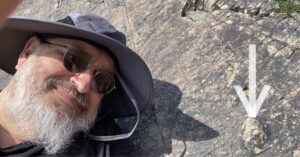
One of these is an ancient time-worn fossil. The other is the impression of an Ediacaran organism.
The fossils are no more than crinkles in the rock, the life-forms having been buried, Pompeii-like, in layers of volcanic ash that settled on the floor of the tropical ocean where they once thrived, the rock setting hard, and, after jostling around on the Earth’s surface came to rest in a quiet corner of Leicestershire, of all places, such that I might come upon them half a billion years later.
*Clean Round The Bend
April 6, 2022
First Person Plural
This first person singular — that’s ‘I’, meaning ‘me’ — has increasing difficulties with the first person plural — that’s ‘we’, meaning ‘us’. Every day I come across phrases, usually freighted with some agonised self-flagellating subtext, or so I assume, that say something like (and I paraphrase here)
We are causing the destruction of the endangered crimp-eyed chuzzbanger
and I ask myself – who is this ‘we’ referred to in the third fifth foregoing?
Does this ‘we’ include me, personally, the reader? If not, all I can say is, well, people, you should do better. For goodness’ sake go forth and improve the status of the crimp-eyed chuzzbanger, and don’t complain to me about it.
If, however, I suspect, the ‘we’ is meant to include me, personally, then I ask myself a more serious question — how is it that the author of these sentiments is so convinced of their rightness such that any view I might have in the matter — someone the author might not know, or have met — is automatically set at naught, having no value, and overridden? Notwithstanding inasmuch as which the case of the crimp-eyed chuzzbanger might merit urgent action, has anyone actually asked me whether I might have an opinion on the matter?
Therefore I ask myself whether the first person plural as presently constituted is too blunt an instrument, or, to use a modish cliche, Not Fit For Porpoises Purpose. For it encompasses many different things, such as (and possibly not exhaustively)
a well-defined group of people that includes the author of the statement and a small group of people in a team that includes the author and known to them. We, this team of conservationists, that’s me and Carol and Bob and Ted and Alice, is going to do something about the crimp-eyed chuzzbanger.a more-or-less well-defined group of people that includes the author but explicitly not anyone who happens to read or hear that statement. We, a team of conservationists, is going to do something about the crimp-eyed chuzzbanger, but you can stay at home.a less well-defined group of people that includes the author of the statement and anyone the author might never have met or know personally, such as readers of a book or the audience of a broadcast. We, humanity in general, need to do something about the crimp-eyed chuzzbanger, irrespective of the views of any individual.The English language is clearly deficient in these shades of meaning. We should do something about it.
March 31, 2022
What I Read In March
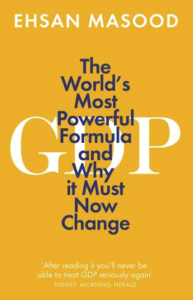 Ehsan Masood: GDP The astute reader will note that this is very similar to Masood’s book The Great Invention, which I read in January. And the astute reader would be correct: the latter book was published in 2016, whereas the new edition takes us up to the COVID-19 pandemic. Much of the content is the same, although there is a completely new chapter on a strain of Marxist macroeconomics in Harvard that Masood unearthed when on a writing fellowship in the United States. For much of the rest I refer you to my earlier effusion. There is one thing, however, that I forgot to discuss. That was the effort by Robert Costanza and colleagues to put a value on all those things the Earth provides us for free, in a now notorious paper, concerning the publication of which I was not entirely unadjacent, during my day job (by day I’m with the Submerged Log Company: if that counts as a disclaimer, I’ll throw in another – the author is a colleague at the same outfit). It seems to me – and this is not entirely my view, as the book makes clear – that one can no longer measure the world’s economy in terms of a metric that measures production and consumption; is expressed as a percentage (and therefore accrues in a compound way); and does so in a world whose resources are demonstrably finite. It’s time, Masood argues, that we found some other means of measuring economic health. That time must be now. There are signs that the global economy has been essentially static for the past twenty years. The reasons given are changes in the mechanics of supply chains, and increased protectionism. But I think there might be a deeper reason: that we’ve essentially run out of resources. People have been warning about this since the 1960s (as Masood amply documents). Seems not many people are listening.
Ehsan Masood: GDP The astute reader will note that this is very similar to Masood’s book The Great Invention, which I read in January. And the astute reader would be correct: the latter book was published in 2016, whereas the new edition takes us up to the COVID-19 pandemic. Much of the content is the same, although there is a completely new chapter on a strain of Marxist macroeconomics in Harvard that Masood unearthed when on a writing fellowship in the United States. For much of the rest I refer you to my earlier effusion. There is one thing, however, that I forgot to discuss. That was the effort by Robert Costanza and colleagues to put a value on all those things the Earth provides us for free, in a now notorious paper, concerning the publication of which I was not entirely unadjacent, during my day job (by day I’m with the Submerged Log Company: if that counts as a disclaimer, I’ll throw in another – the author is a colleague at the same outfit). It seems to me – and this is not entirely my view, as the book makes clear – that one can no longer measure the world’s economy in terms of a metric that measures production and consumption; is expressed as a percentage (and therefore accrues in a compound way); and does so in a world whose resources are demonstrably finite. It’s time, Masood argues, that we found some other means of measuring economic health. That time must be now. There are signs that the global economy has been essentially static for the past twenty years. The reasons given are changes in the mechanics of supply chains, and increased protectionism. But I think there might be a deeper reason: that we’ve essentially run out of resources. People have been warning about this since the 1960s (as Masood amply documents). Seems not many people are listening.
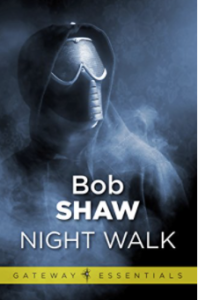 Bob Shaw: Nightwalk The name of Belfast-born Bob Shaw (1931-1996) is little known outside SF circles. This is a shame, but also ensures that each story or novel one uncovers will be an unexplored delight. I picked up this one as a paperback in a secondhand store (the cover here is for the Kindle edition). He is best known, if known at all, for his haunting short story The Light Of Other Days. Perhaps because he suffered from poor eyesight, light and vision are recurring themes in his fiction, and this is brutally so in Nightwalk. Sam Tallon is a spy from Earth who has been sent to the remote planet of Emm Luther to discover the coordinates of a new planet that the Lutherians had come across. Searching for new planets is a risky business. Each new planet is valuable, and planets with established populations will go to war over each discovery. Tallon is caught by agents of the Lutherian secret service, who put out his eyes, and exile him to a version of Devil’s Island – a tropical prison camp surrounded from the mainland by a swamp full of dangers, natural and man-made – from which nobody has ever escaped. But he does. With the help of a fellow inmate and a complaisant prison doctor, Tallon invents a pair of spectacles that allows him to see through the eyes of nearby people, even animals — most notably his faithful seeing-eye dog Seymour (the pun is deliberate). With this McGuffin he manages to … hey, I’m telling you the plot. This cracking adventure story comes from the late 1960s, an era when SF novels were short and sharp, marked by economical writing and pacy plot. Ah, for the light of other days.
Bob Shaw: Nightwalk The name of Belfast-born Bob Shaw (1931-1996) is little known outside SF circles. This is a shame, but also ensures that each story or novel one uncovers will be an unexplored delight. I picked up this one as a paperback in a secondhand store (the cover here is for the Kindle edition). He is best known, if known at all, for his haunting short story The Light Of Other Days. Perhaps because he suffered from poor eyesight, light and vision are recurring themes in his fiction, and this is brutally so in Nightwalk. Sam Tallon is a spy from Earth who has been sent to the remote planet of Emm Luther to discover the coordinates of a new planet that the Lutherians had come across. Searching for new planets is a risky business. Each new planet is valuable, and planets with established populations will go to war over each discovery. Tallon is caught by agents of the Lutherian secret service, who put out his eyes, and exile him to a version of Devil’s Island – a tropical prison camp surrounded from the mainland by a swamp full of dangers, natural and man-made – from which nobody has ever escaped. But he does. With the help of a fellow inmate and a complaisant prison doctor, Tallon invents a pair of spectacles that allows him to see through the eyes of nearby people, even animals — most notably his faithful seeing-eye dog Seymour (the pun is deliberate). With this McGuffin he manages to … hey, I’m telling you the plot. This cracking adventure story comes from the late 1960s, an era when SF novels were short and sharp, marked by economical writing and pacy plot. Ah, for the light of other days.
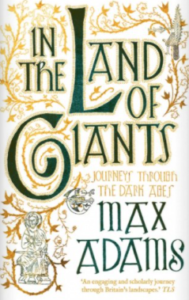 Max Adams: In The Land Of Giants Were I an historian my speciality would be Britain in the 5th and 6th centuries. This is perhaps the most obscure period in our history. No contemporary written record survives from the land we now call England between the sudden collapse of Roman Britain around 410 and the arrival of St Augustine in 597, by which time Britain was a patchwork of petty kingdoms and retained hardly a trace of having been a prosperous Roman province for four centuries. It’s not for nothing that it’s called the Dark Ages. But the Dark Ages weren’t as dark as all that. Many clues lie hidden in the landscape, if you know where to look. Archaeologist Max Adams is one of those who’s been doing the looking. I first came across Adams in his book The King In The North, about the life and times of the subsequently sainted King Oswald of Northumbria. This was especially resonant as I read it while on holiday in Northumbria and could visit some of the places mentioned, such as Hadrian’s Wall, Hexham Abbey, and Bamburgh Castle. But that’s all about the 7th and 8th centuries, when Northumbria emerged from barbarian darkness to become a significant cultural centre. Think the Lindisfarne Gospels and St Cuthbert preaching to the puffins on the Farne Islands; the altogether more worldly St Wilfred, and, most of all, Bede, that son of Jarrow whose Eccelesiastical History of the English People remains a rip-roaring read to this day. That all came to a crashing end with the sack of Lindisfarne by the Vikings in 793. But I digress. More pertinent perhaps is The First Kingdom, in which Adams looks directly at the 5th and 6th centuries — more on that below. In The Land of Giants — cuts across all the others. It is written in the form of a series of travelogues, in which Adams recounts marathon cross-country walks, the occasional motorbike ride, and one memorable boat trip, in which he visits many significant Dark-Age locations in England, Scotland, Wales, and Ireland. These are often revealed only by tiny clues. A curious bend in the road that betrays an ancient field system; the profile of a hill on the skyline; half-buried headstones in ancient graveyards; stones in crumbling churches scavenged from even earlier buildings. What struck me most about the book is Adams’ capacity for endurance. Plainly a seasoned walker, he treks up to twenty-five miles in a single day, often battered by atrocious weather (some things in Britain never change) reading the clues that only the landscape can tell to the trained eye. He reminds me of Jack Corstorphine, the often weatherbeaten landscape archaeologist in my own SF trilogy The Sigil, who disappears into the countryside for weeks on end in search of clues to the vanished past (and I should stress than no resemblance is intended, as I discovered Max Adams long after I wrote the story). I left the book with a sense of envy for that freedom – and for that stamina.
Max Adams: In The Land Of Giants Were I an historian my speciality would be Britain in the 5th and 6th centuries. This is perhaps the most obscure period in our history. No contemporary written record survives from the land we now call England between the sudden collapse of Roman Britain around 410 and the arrival of St Augustine in 597, by which time Britain was a patchwork of petty kingdoms and retained hardly a trace of having been a prosperous Roman province for four centuries. It’s not for nothing that it’s called the Dark Ages. But the Dark Ages weren’t as dark as all that. Many clues lie hidden in the landscape, if you know where to look. Archaeologist Max Adams is one of those who’s been doing the looking. I first came across Adams in his book The King In The North, about the life and times of the subsequently sainted King Oswald of Northumbria. This was especially resonant as I read it while on holiday in Northumbria and could visit some of the places mentioned, such as Hadrian’s Wall, Hexham Abbey, and Bamburgh Castle. But that’s all about the 7th and 8th centuries, when Northumbria emerged from barbarian darkness to become a significant cultural centre. Think the Lindisfarne Gospels and St Cuthbert preaching to the puffins on the Farne Islands; the altogether more worldly St Wilfred, and, most of all, Bede, that son of Jarrow whose Eccelesiastical History of the English People remains a rip-roaring read to this day. That all came to a crashing end with the sack of Lindisfarne by the Vikings in 793. But I digress. More pertinent perhaps is The First Kingdom, in which Adams looks directly at the 5th and 6th centuries — more on that below. In The Land of Giants — cuts across all the others. It is written in the form of a series of travelogues, in which Adams recounts marathon cross-country walks, the occasional motorbike ride, and one memorable boat trip, in which he visits many significant Dark-Age locations in England, Scotland, Wales, and Ireland. These are often revealed only by tiny clues. A curious bend in the road that betrays an ancient field system; the profile of a hill on the skyline; half-buried headstones in ancient graveyards; stones in crumbling churches scavenged from even earlier buildings. What struck me most about the book is Adams’ capacity for endurance. Plainly a seasoned walker, he treks up to twenty-five miles in a single day, often battered by atrocious weather (some things in Britain never change) reading the clues that only the landscape can tell to the trained eye. He reminds me of Jack Corstorphine, the often weatherbeaten landscape archaeologist in my own SF trilogy The Sigil, who disappears into the countryside for weeks on end in search of clues to the vanished past (and I should stress than no resemblance is intended, as I discovered Max Adams long after I wrote the story). I left the book with a sense of envy for that freedom – and for that stamina.
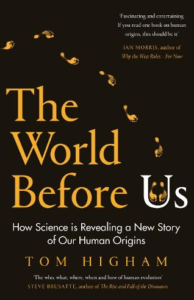 Tom Higham: The World Before Us Back in the 1980s when I was doing my PhD on how to tell the difference between Ice-Age cows (Bos) and Ice-age bison, and if I had a pound for every time I heard the joke ‘what’s the difference between a buffalo and a bison?’, I’d have £874, there was a big problem about dating. That is, it was very hard to put a reliable date on any finds that were more antique than about 47,000 years — the effective limit of radiocarbon dating. If you had volcanic rocks, sure, there was potassium-argon dating, because volcanic rocks contain radioactive potassium that decays reliably into argon, so you could get a fix on the date of the eruption that produced the layers of ash deposited on top of (or underneath) a fossil. And if you had stalactites and stalagmites in a cave, you could measure the decay of radioactive uranium, in the hard chalky substance from which these structures are made, into other elements such as thorium or lead, and so get an idea of when the stalactite or stalagmite formed that capped (or underlay) the deposit in which your fossil was discovered. But if your bones came from an open-air site far from volcanoes, or caves, and were too old for radiocarbon dating to be of much use, you were in a pickle. This was certainly true of many of the cows and bison in Britain, in the Ice Age. Not pickled, that is, but not dateable. Then there was the question of how different all those cows and bison were, really? After all, cows and bison are sufficiently close relatives that they can interbreed. If only we could get their genes down and have a look at them. If that wasn’t enough, I was limited to bones that were complete enough to be identifiable. Not a problem for cows and bison — museums up and down the UK are filled from rafters to basement with boxes marked ‘Bos or Bison?’, so I had plenty to work on and not once did I have to go out into the field to find any more. It’s a problem, though, for much rarer creatures in which some people incomprehensibly take an interest, such as the remains of early humans. (Actually, I did once go out into a field. It was near Clacton. Such is the romance of British Ice-Age palaeontology). But the same museums are also stuffed from rafters to basement with plastic bags full of tiny chips of bone, retrieved from digs, that could have come from anything, awaiting the invention of techniques that could reveal their secrets. At the end of the 1980s I left research and in due course of time I became Bone-Botherer-in-Chief at the Submerged Log Company. During that time I have witnessed a revolution in the science underpinning palaeontology and archaeology. Clearly, I was holding research down by staying. Over the past thirty years our ideas of the period between around 200,000 and 50,000 years ago — crucial to our knowledge of human evolution — has been not so much overturned as transformed and immeasurably enriched by new scientific developments. A key player has been Tom Higham, who, with colleagues at Oxford and around the world, has made carbon dating much more reliable, and has pioneered a method called ZooMS (Zooarchaeology with Mass Spectrometry), in which the identity of otherwise tiny fragments of bone can be established by extracting and sequencing the constituent amino-acids of any collagen they contain. Collagen is the raw material for carbon dating. Now it’s possible to read off the species whence a bone fragment came, as well as its age. The same is true for the genetic material, DNA. The sequencing of ancient DNA was pioneered by the remarkable Svante Pääbo whose book Neanderthal Man tells all. Higham’s The World Before Us is much the same. It’s an engaging personal tale of discovery, enriched by from-the-horse’s-mouth descriptions of the science and its importance. I should declare an interest here, as I play walk-on parts in both books, and indeed Pääbo features strongly in Higham’s account, especially concerning the revelations from Denisova Cave in the Altai Mountains of southern Siberia. It was here that the remains of a hitherto unknown yet extinct relative of humans was discovered. The Denisovans, close kin to the Neanderthals, lived in the region until around 50,000 years or so, but their DNA lives on, especially in people from Island Southeast Asia — just as the DNA of Neanderthals lives on in everyone without a purely African ancestry, signs of interbreeding in the long past. Denisovans are known almost exclusively from tiny fragments, but we know an amazing amount about them thanks to the DNA and collagen that these fragments contain. This would have been impossible without the science pioneered by Higham, Pääbo and their associates. I enjoyed The World Before Us hugely, and will treasure it as a personal account of an amazing period in archaeological science, but perhaps I am biased as I have a close interest in the science and know some of the protagonists personally. I wonder whether a less clued-up reader might find some of the more technical parts hard going, although I for one appreciated Higham’s description of Bayesian statistics, something that hitherto I have found as hard to grasp as a hot buttered ferret skittering down a drainpipe.
Tom Higham: The World Before Us Back in the 1980s when I was doing my PhD on how to tell the difference between Ice-Age cows (Bos) and Ice-age bison, and if I had a pound for every time I heard the joke ‘what’s the difference between a buffalo and a bison?’, I’d have £874, there was a big problem about dating. That is, it was very hard to put a reliable date on any finds that were more antique than about 47,000 years — the effective limit of radiocarbon dating. If you had volcanic rocks, sure, there was potassium-argon dating, because volcanic rocks contain radioactive potassium that decays reliably into argon, so you could get a fix on the date of the eruption that produced the layers of ash deposited on top of (or underneath) a fossil. And if you had stalactites and stalagmites in a cave, you could measure the decay of radioactive uranium, in the hard chalky substance from which these structures are made, into other elements such as thorium or lead, and so get an idea of when the stalactite or stalagmite formed that capped (or underlay) the deposit in which your fossil was discovered. But if your bones came from an open-air site far from volcanoes, or caves, and were too old for radiocarbon dating to be of much use, you were in a pickle. This was certainly true of many of the cows and bison in Britain, in the Ice Age. Not pickled, that is, but not dateable. Then there was the question of how different all those cows and bison were, really? After all, cows and bison are sufficiently close relatives that they can interbreed. If only we could get their genes down and have a look at them. If that wasn’t enough, I was limited to bones that were complete enough to be identifiable. Not a problem for cows and bison — museums up and down the UK are filled from rafters to basement with boxes marked ‘Bos or Bison?’, so I had plenty to work on and not once did I have to go out into the field to find any more. It’s a problem, though, for much rarer creatures in which some people incomprehensibly take an interest, such as the remains of early humans. (Actually, I did once go out into a field. It was near Clacton. Such is the romance of British Ice-Age palaeontology). But the same museums are also stuffed from rafters to basement with plastic bags full of tiny chips of bone, retrieved from digs, that could have come from anything, awaiting the invention of techniques that could reveal their secrets. At the end of the 1980s I left research and in due course of time I became Bone-Botherer-in-Chief at the Submerged Log Company. During that time I have witnessed a revolution in the science underpinning palaeontology and archaeology. Clearly, I was holding research down by staying. Over the past thirty years our ideas of the period between around 200,000 and 50,000 years ago — crucial to our knowledge of human evolution — has been not so much overturned as transformed and immeasurably enriched by new scientific developments. A key player has been Tom Higham, who, with colleagues at Oxford and around the world, has made carbon dating much more reliable, and has pioneered a method called ZooMS (Zooarchaeology with Mass Spectrometry), in which the identity of otherwise tiny fragments of bone can be established by extracting and sequencing the constituent amino-acids of any collagen they contain. Collagen is the raw material for carbon dating. Now it’s possible to read off the species whence a bone fragment came, as well as its age. The same is true for the genetic material, DNA. The sequencing of ancient DNA was pioneered by the remarkable Svante Pääbo whose book Neanderthal Man tells all. Higham’s The World Before Us is much the same. It’s an engaging personal tale of discovery, enriched by from-the-horse’s-mouth descriptions of the science and its importance. I should declare an interest here, as I play walk-on parts in both books, and indeed Pääbo features strongly in Higham’s account, especially concerning the revelations from Denisova Cave in the Altai Mountains of southern Siberia. It was here that the remains of a hitherto unknown yet extinct relative of humans was discovered. The Denisovans, close kin to the Neanderthals, lived in the region until around 50,000 years or so, but their DNA lives on, especially in people from Island Southeast Asia — just as the DNA of Neanderthals lives on in everyone without a purely African ancestry, signs of interbreeding in the long past. Denisovans are known almost exclusively from tiny fragments, but we know an amazing amount about them thanks to the DNA and collagen that these fragments contain. This would have been impossible without the science pioneered by Higham, Pääbo and their associates. I enjoyed The World Before Us hugely, and will treasure it as a personal account of an amazing period in archaeological science, but perhaps I am biased as I have a close interest in the science and know some of the protagonists personally. I wonder whether a less clued-up reader might find some of the more technical parts hard going, although I for one appreciated Higham’s description of Bayesian statistics, something that hitherto I have found as hard to grasp as a hot buttered ferret skittering down a drainpipe.
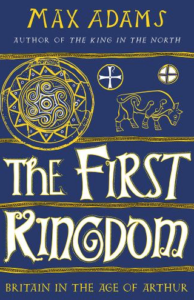 Max Adams: The First Kingdom I read this late last year but it inexplicably didn’t make my top ten. My excuse is that I read so many books last year that I must have overlooked it. I knew I was going to re-read it, so here it is now. It’s about that most obscure period in the history of Britain, the fifth and sixth centuries. The Romans left Britain rather abruptly in 410. They came back in 597 in the form of Augustine’s mission to the King of Kent. In between the country turned from an orderly, prosperous province of Rome where people spoke Brythonic (a close relative of Welsh) and Late Spoken Latin, to a patchwork of fiefdoms where people spoke what King Alfred later called Englisc. The almost total lack of contemporary written evidence has made the transition between the two obscure. In this brilliant book Max Adams explains what we do know (and it’s more than we think) and constructs a plausible hypothesis to resolve the many contradictions and fill the large gaps in the tale. We know that the economy collapsed – no Roman coins are found in Britain that date to later than 410 – along with the standard of living, and the population. In many parts of Britain, people went back to the kind of locally based, subsistence existence they had enjoyed (if that’s the word) before the Romans came. Local Roman commanders and opportunists among the population sequestered what wealth there was – it became privatised. Adams doesn’t say so, but it reminded me of the rise of the oligarchs after the collapse of the Soviet Union. And at some point, the Angles, Saxons and Jutes arrived. The simple story of battle, fire and plunder familiar from Bede (who wrote much later), and that dyspeptic British chronicler Gildas (who was contemporary, writing around the year 500, but whose horizons did not stretch beyond Wales) is not borne out by the archaeology. Some Germanic people were probably already settled on the east coast while Britain was nominally Roman. Others were undoubtedly piratical and established pirate bases in creeks and estuaries, in Essex and Suffolk. More came, but the transition from Brythonic Christianity to Germanic heathenism might have been a process of acculturation as well as migration. For example, Cerdic, the culture hero said to be the founder of what became Wessex, and therefore England, is a suspiciously Brythonic name. And Adams makes the point that the presence of Japanese cars in Britain today doesn’t mean that Britain has been invaded by Japan. Neither does the fact that many people in Holland speak excellent English imply that the English have invaded the Netherlands. There was also a marked division between the north and west, and the east and south. In the former, the domain of St Columba and St Patrick, Celtic Christianity survived, and people lived a more Roman existence than perhaps they ever did while the Romans were still around. Trade by sea brought goods from the fading Empire – wine, olive oil, fine tableware – at least until the climatic downturn and plague associated with the reign of Justinian in the mid sixth century. Eastern England and lowland Scotland, in contrast, became, if not Saxon, then Saxonised. Max Adams traces how the country developed from a quilt of tiny territories, sometimes traceable to this day from the landscape, and ancient parish boundaries, to larger realms defined by established custom. Slowly, surpluses built up that allowed the persistence of a warrior class that lived on the render of the classes below. The great change happened when the country became largely Christianised. Rather than building pocket empires by the sword, which vanished as soon as they died, kings ruled by divine grace conferred by clerics, in exchange for lands given to the church in perpetuity. This created continuity. It allowed churches to accumulate capital, invest in the landscape and in activities such as literature, and, from the dark ages, England emerged as a country of lore and literature once more.
Max Adams: The First Kingdom I read this late last year but it inexplicably didn’t make my top ten. My excuse is that I read so many books last year that I must have overlooked it. I knew I was going to re-read it, so here it is now. It’s about that most obscure period in the history of Britain, the fifth and sixth centuries. The Romans left Britain rather abruptly in 410. They came back in 597 in the form of Augustine’s mission to the King of Kent. In between the country turned from an orderly, prosperous province of Rome where people spoke Brythonic (a close relative of Welsh) and Late Spoken Latin, to a patchwork of fiefdoms where people spoke what King Alfred later called Englisc. The almost total lack of contemporary written evidence has made the transition between the two obscure. In this brilliant book Max Adams explains what we do know (and it’s more than we think) and constructs a plausible hypothesis to resolve the many contradictions and fill the large gaps in the tale. We know that the economy collapsed – no Roman coins are found in Britain that date to later than 410 – along with the standard of living, and the population. In many parts of Britain, people went back to the kind of locally based, subsistence existence they had enjoyed (if that’s the word) before the Romans came. Local Roman commanders and opportunists among the population sequestered what wealth there was – it became privatised. Adams doesn’t say so, but it reminded me of the rise of the oligarchs after the collapse of the Soviet Union. And at some point, the Angles, Saxons and Jutes arrived. The simple story of battle, fire and plunder familiar from Bede (who wrote much later), and that dyspeptic British chronicler Gildas (who was contemporary, writing around the year 500, but whose horizons did not stretch beyond Wales) is not borne out by the archaeology. Some Germanic people were probably already settled on the east coast while Britain was nominally Roman. Others were undoubtedly piratical and established pirate bases in creeks and estuaries, in Essex and Suffolk. More came, but the transition from Brythonic Christianity to Germanic heathenism might have been a process of acculturation as well as migration. For example, Cerdic, the culture hero said to be the founder of what became Wessex, and therefore England, is a suspiciously Brythonic name. And Adams makes the point that the presence of Japanese cars in Britain today doesn’t mean that Britain has been invaded by Japan. Neither does the fact that many people in Holland speak excellent English imply that the English have invaded the Netherlands. There was also a marked division between the north and west, and the east and south. In the former, the domain of St Columba and St Patrick, Celtic Christianity survived, and people lived a more Roman existence than perhaps they ever did while the Romans were still around. Trade by sea brought goods from the fading Empire – wine, olive oil, fine tableware – at least until the climatic downturn and plague associated with the reign of Justinian in the mid sixth century. Eastern England and lowland Scotland, in contrast, became, if not Saxon, then Saxonised. Max Adams traces how the country developed from a quilt of tiny territories, sometimes traceable to this day from the landscape, and ancient parish boundaries, to larger realms defined by established custom. Slowly, surpluses built up that allowed the persistence of a warrior class that lived on the render of the classes below. The great change happened when the country became largely Christianised. Rather than building pocket empires by the sword, which vanished as soon as they died, kings ruled by divine grace conferred by clerics, in exchange for lands given to the church in perpetuity. This created continuity. It allowed churches to accumulate capital, invest in the landscape and in activities such as literature, and, from the dark ages, England emerged as a country of lore and literature once more.
March 25, 2022
Commutatis Maledictis
London!
London!
(It’s only a model).
London!
On second thoughts, let’s not visit London. It is a Silly Place.
Notwithstanding inasmuch as which it’s almost precisely approximately exactly two whole years since I have been to the London Orifice (I’m with the Submerged Log Company), I still get anxiety dreams about commuting. These dreams are protean and likewise variable, but these days take the form of my confusion at being confronted with an entirely changed and different London tube map. Old lines have been extended in severally all directions.
Old stations have new names.
There are lots of new stations.
One of these was called ‘Nope’.
When I am – in my dreams – at these stations – there are few clues as to which direction the trains are headed, and indeed if any are headed towards termini with which I have some familiarity such as King’s Crustacean(1). Other passengers are eager to help but are so far ahead in their metropolitan sophistication that I am none the wiser.
Well, imagine my horror at discovering only yesterday that there exists a new line called the Elizabeth Line of whose existence I had been entirely ignorant. On later inspection I discover that it used to be called Cross Rail. Cross? I was furious. What next? The Onedin Line? The Mason-Dixon Line? The Wallace Line?
I think I’ll stay at home.
(1) King’s Crustacean gets its name from the presence, in the 18th century, of large seawater aquaria that were used to store fresh crabs and lobsters, imported from Cromer, for the table of King George III. It replaced an aquarium at Charing Crustacean, and was superseded by New Crustacean.
March 22, 2022
World Poetry Day
Yes, I know, I know, World Poetry Day was a few days ago now, and as you read this it’s probably World Broccoli Day or World Make-Friends-With-A-Unicycling-Girrafe Day, but at the age of 59 and 11/12ths I’m a bit slow on the old unicycle release of calcium from intracellular stores uptake and it took me a while to retrieve this poem I wrote some years ago on the occasion of the confirmation of the existence of the Higgs Boson. So here it is. With apologies to Hilaire Belloc.
Ahem.
Clears throat.
THE BOSON
The Boson is so very small
You cannot make it out at all
Though scientists have money on
Its presence in the Tevatron.
Notwithstanding the concern
Of colleagues working hard at CERN
Who hope the Boson might emerge
Triumphant, from a mighty splurge
of hadrons which, when they collide
Release their secrets, locked inside.
Why all this fuss, I say? Alas!
Without it, and we’d have no mass
We’d float away, like thistledown,
Drifting high above the ground.
The ground itself would fly away
And nothing much would deign to stay
Attracted to its bounden mate.
We’d be in such a sorry state!
But hold! We cannot be so free.
There is still much uncertainty,
For scientists tell us we must wait
For sigmas to accumulate.
Oh let us never, ever doubt
What nobody is sure about.
It’s OK, I’m going now.



